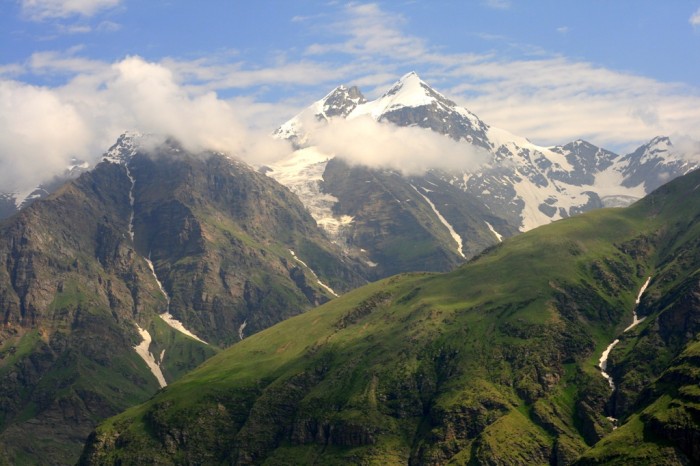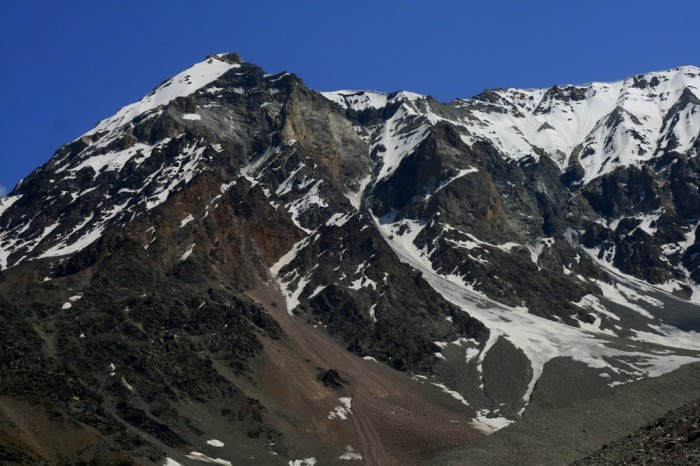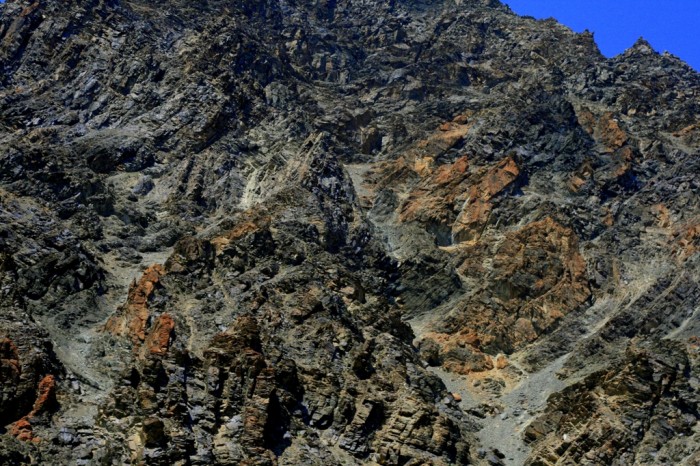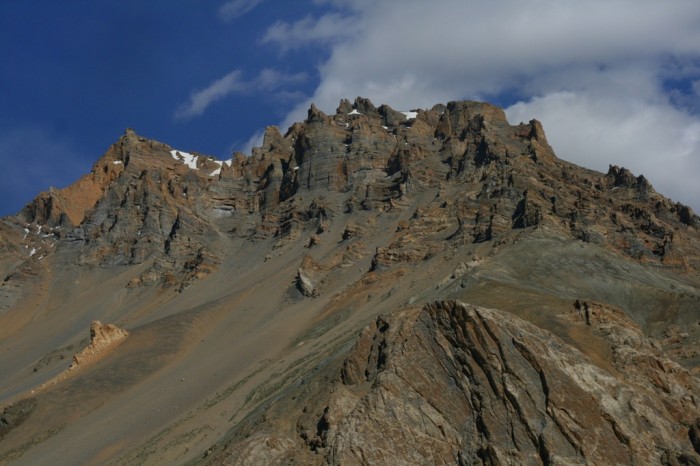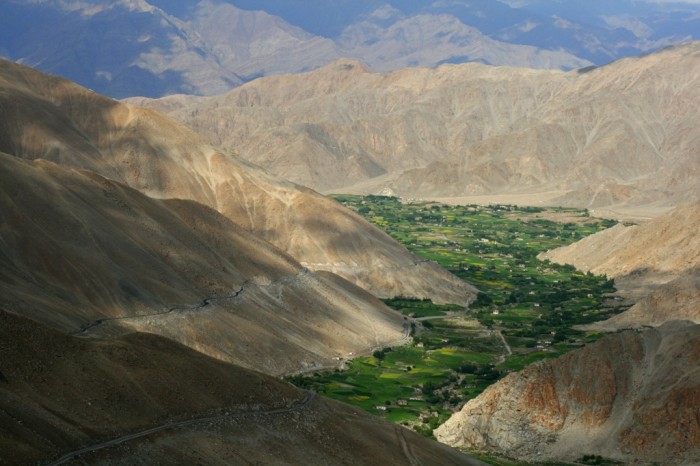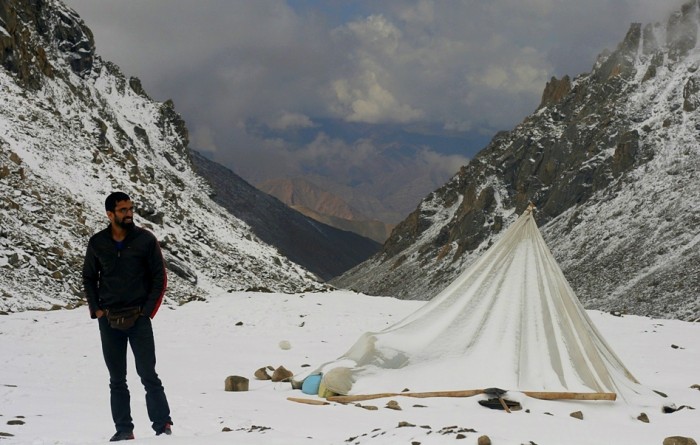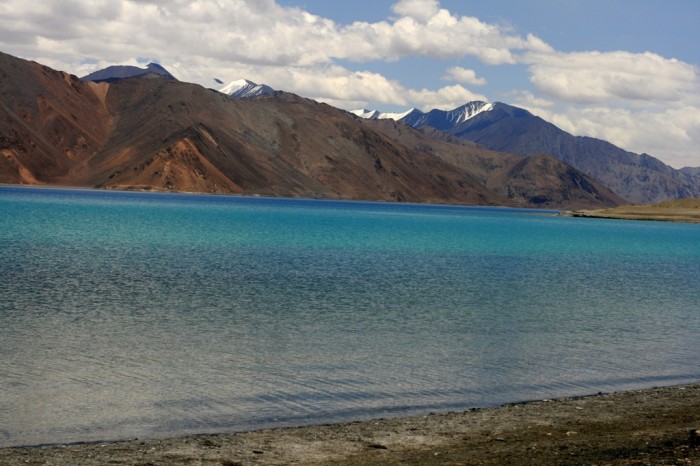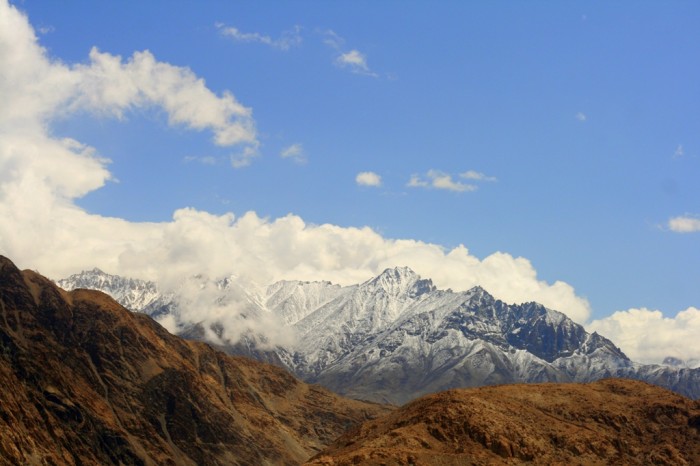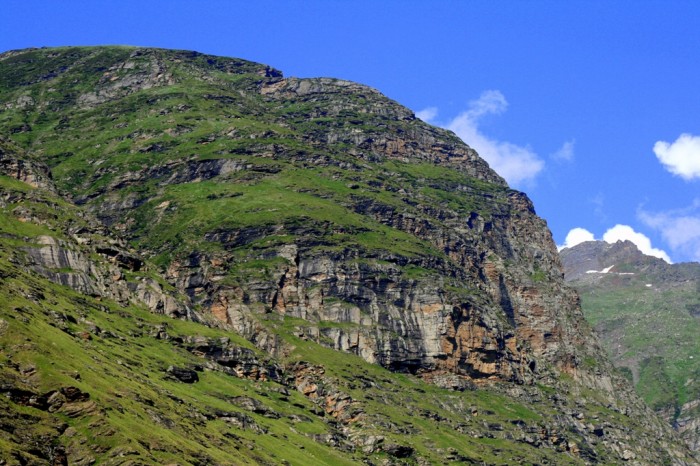Click on the pics themselves to load them larger
Its funny how you can feel completely alright just after you’ve thrown up. What’s even more ironic is that my teeth are chattering and my fingers are like ice and yet I can’t bring myself to crawl back under a thick blanket. I just sit on the gravel abour a foot away from where I’ve vomited and look up at the sky full of stars. Everything around me is dead to the world. My companions are fast asleep in a large tent. There’s no sign of life here. Not even any trees. I have laboured breathing and yet all I can keep thinking is how gorgeous this place is. Ironic, because only ten minutes earlier I was wishing that I was back home in Goa.
Modern travel is such a strange thing I think to myself. Less than forty eight hours ago I was back home. In my comfort zone. All I did was take one flight to Delhi, a bus to Manali, and then get on this Tempo Traveller to land in the middle of nowhere. I gulp some water and the cold liquid soothes my stomach. The previous evening I was lesurely walking in Manali. Completely unaware of the ardous journey I was scheduled to make.
I had landed in Manali in the morning, found a cheap room, and booked my ticket on this tempo traveller that would take me to Leh. I tried to sleep early that night and failed. I had barely slept for an hour before the alarm went off. It was two in the morning. Time to get to the ‘pick up’ spot for the Leh tempo. All I have is a bus number. A tempo traveller arrives around two. But it’s not mine. It takes away the only two people waiting along with me. Now I’m sitting all alone in almost pitch darkness.
By two thirty I’m beginning to get worried. I call the only cell number I have and a sleepy voice reassures me that the tempo traveller will arrive. It never does. In the end a car passing along the road stops. The driver seems to know the bus and offers to drop me there. I finally find my tempo traveller. It is parked besides a small snack bar and surrounded by backpackers. They are singing, eating, drinking and smoking weed. The tempo driver is smoking weed too. Turns out we are still waiting for two more people.
By the time we leave it is about four in the morning. I have the front seat next to the driver. It has its advantages (clear view of the road and the least bumpy spot) and disadvantages (no push back option so no sleep for me). The cold night air is refreshing and within minutes we are out of Manali and winding our way up a mountain. It isn’t long though before we hit a traffic jam. Turns out all the cars leave at the same time and there’s only one narrow road all the way up to Leh!
No worries. This apparently happens all the time. The driver jumps out of the tempo traveller and disappears ahead. I sit and listen to the soft snoring from the seats behind me. Thirty minutes later I hear yelling far away. Twenty seconds later our driver is dashing towards us. He guns the engine to life and we’re off.
Twenty minutes later a tempo behind us is honking like a maniac. ‘let the lunatic overtake’ I say to the driver. Turns out he’s trying to tell us we have a flat tire. The driver jumps out. I jump out. I’m freezing even though I’ve got my mittens, wollen cap and leather jacket on. The driver though is clad in just a t shirt. He smirks at me shivering. In ten minutes later he’s got the tire replaced. Thirty minutes later we ae at another traffic jam. The famous Rotang pass. Probably the most trecherous part of road on this trip. Rotang apparently means ‘pile of dead bodies’. The name comes from the hundred of people who’ve lost their lives trying to cross this area.
Looking at the size of the traffic jam I can easily imagine how we could have another ‘pile of dead bodies’. All we need is one decent landslide.
The road to Manali only opens mid June when the army clears the rubble from the frequent landslides. Three months later it is closed again for the winter. And even during the short three months the landslides don’t stop. It isn’t unusual to be spending several days in Manali till the army has finished clearing a fresh landslide.
I’m here on the 2nd of July. Only eleven months earlier was my first attempt at getting to Leh. That journey had ended even before I could leave Delhi: I had landed in Delhi on the very day a flash flood hit Leh and killed hundreds of people. Leh was destroyed. If you were in Leh you had no way of getting out of there.
In the light of that this traffic jam didn’t seem so bad at all. After all we were stuck behind only about two hundred trucks on a narrow slush path that, along its edge, dropped several hundred meters to the bottom. Besides we were still moving and maintaining a steady pace of about four feet an hour!
It was now almost eight in the morning and I was having my first view of snow capped mountains. The morning sun bathed the white peaks in golden light. I was excited and enjoying myself even though we seemed to be stuck in this jam indefinitely.
But this was what I’d signed up for even before I had made the journey. Part of the charm of getting to Ladhak is the unpredictability. Whether you like it or no you’re basically doomed to have a unique experience. Tell anyone you know that you’re going to Ladhak and they are immediately jealous. Because they know it requires more than just a ticket booking and some warm clothes to get there.
By nine in the morning our tempo has finally made it across a fifty meter slush filled patch of road. Muck covers everything outside: trucks, cars, motorcycles and motorcycle riders. I do some metal arithmetic and realize that it has taken us over six hours to cover a distance of 50 odd kilometers. Suddenly the 450 odd kilometers left don’t seem so close anymore.
But the driver assures us that the rest of the journey won’t have traffic jams. But we could still have a landslide blocking the way. And of course we still haven’t fixed that flat tire. But for now we are climbing steadily and the road is bad and everything around us is shrouded in mist. So there isn’t much of a view but it’s still very beautiful. We stop at a tea shop and I have an omlette. Then I make the mistake of asking for milk and get watered down sugary white liquid. Meanwhile the has managed to persuade a buddy of his going down to Manali to give us his spare tire and take the flat one back with him.
Now that the light is up I start fraternising with my co travellers. There’s two israeli women, two south african women, one canadian woman, two indian men, an american couple and the american guys father. Apart from the father everyone seems below 25 years of age. At 31 I feel old. Like a late starter in life. I get chatting with the canadian and the israeli women and we discuss plans to rent a jeep together to see Nubra valley and Pangong lake when we get to Leh.
Now the sun is also up though and we have spectacular views of the mountains around us. Small waterfalls tumble down some of them and most of them are atleast partially green. The green comes from grass and small shrubs that manage to get a foothold on these practically vertical mountainfaces. Some of the highest peaks are covered in white snow that even from a distance dazzeles in the sunlight.
Emily (the canadian woman) points out a glacier to me. I’m surprised. It definitely seemed different when I saw it but then dirtied by mud I would never have recognized it. I snap away with my camera.
We descend as steeply as we ascend and then cross a bridge. Then we ascend up and around the next mountain. This ‘ascend, descend, cross a bridge and then ascend’ formula will be repeated practically throughout the journey to Leh. At times when we cross a bridge there will be a torrent below it. At other times we just pass a dry valley. What won’t repeat though is the shape, texture and colour of the mountains. They constantly change. It’s a suble change but you do notice it.
In a few hours for instance I notice that the moutains aren’t even partially green anymore. They are bare. Dirty glaciers litter some of them and snow covers the tops of many of them but we seem to have passed the limit for shrubs and grass.
For the most part of our drive we pass another vehicle every ten to twenty minutes. Every hour and a half we might hit a sign of civilisation – a small group of ugly concrete and tin roofed huts strung together along the side of the road. There’ll usually be a check point here and all the foreigners will have to show their passports. I don’t have to. Not even an identification card. Apprently me speaking in Hindi is good enough for them even though at first glance they assumed I was israeli!
Up and down we go. At times the road is nice at times there is no road. But the drive remains amazing all the time. I am surprised. This land keeps you gawking at its landscapes even though they’re built with just rocks, sand and some snow. I keep shaking my head in wonder at the fact that not for a single instance on this drive to Manali do you feel like you’re repeating a mountain or a landscape.
By noon we stop at at a dusty fuel station which proudly announces ‘next petrol pump 385 kilometers away.’! Soon after tanking up at the station everyone is jolted awake by a loud gunshot. The driver brings the tempo traveller to a half. It’s another flat tire.The driver has the spare tire on in a jiffy.
The flat tire isn’t just flat. It’s ripped. Unrepareable. Which isn’t surprising considering the ‘bang’ it went out in. I ask the driver about the chances of finding another one of his buddies we can exchange a tire with. He has an stunned look on his face. It almost reads ‘look around do you see any people let alone possible buddies?’.
With good reason we are all nervous now. Excepting for the driver. Who pats the spare tire reassuringly. ‘This one will work fine for the rest of the journey’ he smiles reassuringly. Even if that were true I want to point out the obvious remaining three bald tires but refrain from doing so. There’s no room for pessimism and negativity on this trip. Realism isn’t good enough. Only optimism will get us there.
Two hours later we stop for lunch. Tea, maggi noodles and omlettes are served inside a small tent. I sit out. The sun is strong and my neck starts to burn. Then there’s a sudden gust of icy wind and I shiver. The wind drops and the sun burns my neck again. At this rate I will have to be putting on and pulling off my jacket every two and a half minutes.
But I’m just nagging. I should appreciate the spectacular view of snow covered moutain barely a hundred meters from where I sit. I look around at the mountains. They are definitely different from what we call mountains back home in Goa. Ours are hillocks and small mounds of mud with gentle slopes to the top. Moutains that allow you to carry a sizeable picnic bag to the top.
Not these mountains. These only have slopes that are 50 degrees or steeper to the top. Which makes them look alive. Like they are growing everytime I turn my back on them. Like big stony giants sitting camouflaged waiting to stand up and stretch when they hear the right magic word. ‘Open Sesme?’. For the first time I can appreciate the saying ‘standing on the shoulders of giants.’ In comparising our hillocks back home look like placid cows nodding gently everyonce in awhile.
I consider the fact that the thin air is starving my brain of oxygen which is why I’m having these hallucinations. But I’m enjoying this mild LSD trip.
‘No I’m feeling great!’ I exlaim to Lon (the older american) when he asks me if I’m feeling any kind of mountain sickness. Lon’s concerned since I’ve made my way from sea level to over four thousand feet in such a short time. I smile inwardly. These lesser mortals don’t know the meaning of being fit. The only problem I am going to have as a result of being so fit is that I’ll have to take care of everyone else when they fall sick. Oh the annoyances of being in great shape.
But by evening I’m not feeling so great anymore. Infact I’m beginning to feel a bit sick. I can’t believe this is happening. Maybe it’s the winding roads. I finally take up the Israeli girl on her offer to change seats incase I wanted to rest a bit. I try to catch a bit of shut eye on the reclined seat but its useless. Even if I could feel sleepy I won’t get any at the rate this damn tempo traveller is bouncing around.
By seven in the evening the driver takes a decision. We’re gonna stop for the night. Some of the girls are disappointed. They were hoping to do the journey all in one go. Drive through the night. I pretend like I’m a bit disappointed too to save face. But really I’m relieved. I rush into our tent for the night and collapse onto a bed. The girls are now getting concerned. From damsels in distress they’ve changed to take on the role of elder sisters and worried mothers.
‘You must eat something Rahul. Atleast a little.’
‘If you need anything don’t’ hesistate to wake me up ok?’ says another.
If I wasn’t so sick I might have exploited all the advantage I had. Perhaps asked for a nice body massage. But right now all I can manage is laboured breathing. Lon now highly recommends the mountain sickness medicines he’s carrying. If I do get mountain sickness there will be no alternative but to rush back down to a lower altitude. I take the medicines and keep them with me. If I don’t feel better soon I’m taking them.
I’m in bed from nice in the night to twelve. We’ve stopped at 4400 meters and its not at all recommened to do so on the first day. At 3500 meters Leh has a much lower chance of giving you mountain sickness. The air is so thin here I can’t fill my lungs. I drift off to sleep only to wake up with a start realizing that I’m suffocating. Then I hyperventillate. The others finish their food, chat and then fall asleep. I keep gulping small quantities of water but what’s strange is that I can’t seem to fill my bladder. The water seems to remain unabsorbed and slushes around in my stomach. Close to midnight I’m beginning to feel really sick and I finally take the medicines. An hour later I rush out the tent almost not making it outside and nearly throwing up on one of the sleeping girls faces in the process.
I get only a couple of hours of sleep after that but when I wake up in the morning I feel ready to take on the world. By seven in the morning we leave. The spectacular scenery continues. All of us realize that it was a good idea to have avoided the night journey. Driving in the dark and missing all of this would have been such a shame.
About an hour later I suddenly begin to feel a strange sensation in my lungs. Like there’s something heavy filling up the area just behind my solar plexus. At first I try to ignore it. I breathe deeply thinking it will go away. But it doesn’t. In fact it starts to get worse. Soon even my lungs are beginning to feel like they are filling up with something. I panick. Oh no not pulmonary odema I think to myself.
And what the hell am I supposed to do if I have it. We are probably still two hundred kilometers away from Leh, driving on a road where the only signs of life are when we pass a shepard with a flock of sheep every thirty minutes and a tempo or jeep going in the direction of Manali every forty minutes. If that wasn’t enough we’ve had no cell phone reception since we left Manali and are still traveling with no spare tyre. I must make it to Leh I tell myself. There’s surely be a hospital there. Maybe they might even have a helicopter to fly me out if things really get bad.
I turn to look back at Lon who’s dozing off in the back seat. He seems to be the most knowledgeable on the subject of mountain sickness and I relate my symptoms to him in as nonchalant a way as I possibly can. Lon is intrigued. ‘I’m not sure what’s going wrong with you Rahul’ he calmly answers like a doctor poking around bemused at an inoperable tumor.
The girls of course think that the only medicine for all of this is to eat something. ‘Eat these biscuits, Rahul. Have some of these chips Rahul. Drink some of this juice Rahul.’
But fortunately I don’t have pulmonary odema. It’s probably just the combination of thin air and exhaused stomach muscles from throwing up that gave me the feeling. When we descend a little later the strange feeling is gone.
When we finally get to Leh it is past noon. The sun shines brightly but the air is plesant and dry. The girls are checking their cell phones which are still not working. Amateurs, I smile to myself. I on the other hand have come prepared. I fish out my government owned BSNL sim card and replace my other sim card. What! No network on my phone too. So much for being a pro.
I’ve come to without any plan or contact for a place to stay. I’m a much more relaxed traveler in India now and I assumed that I would find a place on the spot. But the girls already have an idea where to find a place to stay so I tag along with them. I stand and watch as they skillfully bargain the taxi driver down to a hundred and fifty from three hundred. I’m embarrased knowing that I would have been proud to bring it down to two hundred!
We find a few rooms in one of the quieter areas of Leh town. My room is serviced by a common bathroom and toilet but at Rs 250/- only it is a steal. Emily asks me if I’m comfortable sharing the room with her and since I am I actually end up paying only Rs 125/- per night!
We’ve barely got our bags into the room when Emily manages to chat up some young Israeli travellers who are making a journey to Nubra valley the next day. She’s comes charging back from the travel agent next door to tell me that the Israelis are travelling with two jeeps and they have two spare seats at Rs 1100/- each. I pat Emily on the back and we dash back to the travel agency to tell them that we will take them up on their offer. I spend the rest of the day resting and occasionally making a short trip to the cheap restaurant also next door. It is highly recommended that you acclamitize by taking bed rest for atleast a day when you land in Leh. Considering how I fared on the journey to Leh I know that to be no laughing matter and I take my rest very seriously.
The next morning Emily and me are at the travel agent’s place by eight in the morning. Besides us there are nine Israelies and one young handsome soft spoken britisher called Philip. I find some of the Israelies very goodlooking too. While they turn out to be well travelled and fully capable of holding up their end of the conversation they definitely aren’t as soft spoken as Phil; a trait of theirs that will get us into some serious arguments with the drivers of the jeeps later on.
For the moment though everything is beautiful and peaceful. I have unscrupulously jumped into the front seat and am enjoying the view as we climb up and out of Leh town. The driver is a young north indian with slits for eyes. He’s thrilled to know that I speak hindi and form then on I’m his official translator and entertainer.
‘Ask the Israeli’s sitting in the back if I can turn on my stereo. I’ve got some lovely Hindi music.’
I turn my head back and translate.
‘No. we prefer if there’s no music.’ comes the reply. This time I’m on the side of the Israelies though.
‘What about that girl sitting at the back? Is she with them.’
‘Oh that girl is not. She’s canadian and I travelled with her from Manali.’
‘She’s gorgeous. Where’s she staying?’
‘Oh we’re staying together in a room behind the travel agents.’
‘Wow, so you’re having a nice time with her huh?!!!’
‘Oh no no. its not like that. Nothing’s happening there’
‘WHAT? Don’t lie to me you sneaky bastard. you two lying on the same bed and nothing happening. Make a move man. She’s waiting for it.’
‘Oh I highly doubt it considering she’s always talking about her boyfriend back home.’
‘She’s gorgeous man. Oh if I had a woman like that…heaven.’
I try to change the topic. But the driver is good not just on the road but at finding all tracks that leads back to Emily. For the next twenty four hours he will keep badgering me with questions about her. By the second day I am convinced that he is seriously in love with Emily and I tell her about it. She’s all giggles and smiles.
About an hour and a half into the journey we reach Khardungla. At 5800 meters above sea level it is the highest motorable pass in the world. Even now at the peak of summer and in the middle of the day the pass has snow on either side of it. The pass is very touristy and tens of jeeps are parked here. Surprisingly there are a lot of Indian families here.
Most Indians couldn’t be bothered torturing themselves with the Manali to Leh bus ride so they fly directly to Leh from Delhi. They comprise the honeymooning couples, three generation families, and a surprising number of affluent retired elderly people. You can tell they’re affluent because they all have expensive cameras and absolutely no clue as to how to use them. Half of them are obese and can just about manage lifting themselves out of the jeep and walking a few steps to the café on the other side of the road. They aren’t going to Nubra valley for sure.
From Khardungla we descend towards Nubra Valley. Over eight percent of the jeeps at Khardungla will remain behind. The road is bad but the views are spectacular. It isn’t long though before we have to stop. There’s a landslide being cleared and we’ll have to wait. How long? No one knows. It takes over an hour for the landslide to be cleared and then we are moving again.
To get to Nubra valley we chase a gigantic valley that cuts between big bare grey moutains. I’ve seen footage of the Grand Canyon in America and this seems just as impressive. The road we are on snakes its way around moutains and for much of the journey the valley remains on our right.
We pass many army truck convoys and they keep reminding us of how close we are to the Indian border. We also pass a lot of young Indian men on Royal Enfield motorcycles. They are the ones who won’t take the mini bus from Manali, nor will they take the direct flight from Delhi to Leh.
For them Ladhak is the ultimate biking challenge. For most of them the jouney starts in Delhi and ends in Khardungla. Some of them though will continue into Nubra valley. All of them wear complete riding gear including jackets, knee guards, and helmets. When they complete this journey it will count as one of the major achievements in their life and they take all the riding very seriously.
I like bikes and own a Royal Enfield myself. So before getting to Leh I had considered the possibility of me joining a biking group myself. But after seeing the terrain and the extreme weather the bikers put themselves through I was certain that I was much better off in the comfy jeep!
By evening we reach a small village in Nubra Valley. We make arrangements for the twelve of us to share four big rooms. I pick the one with Emily and Philip. We find a place to eat and by nine in the night I go off to bed. Everyone else is in the courtyard outside the room chatting and playing cards.
Around eleven in the night Philip comes in. Apparently there’d been a fight between the two drivers and the Israelies. Apparently the Israelies wanted to visit a remote village the next day and the driver told them he didn’t have permission to do so. I listen to both sides of the story in the morning and realiz that the problem is that the Israelies have signed up for the cheaper package and with good reason the driver is unwilling to take us all there.
By the time we leave for the camel safari it is almost ten in the morning. In the car I can cut the thick air between the israelies and the driver with a knife. When we finally reached the site where the camel safari takes place the Israelies decide that they are going to do a seven kilometer walk back to the village where we were staying. That not being in the package the driver begins to get really agitated. He seems to be in a hurry to get back home and he keeps hounding me to warn the Israelies that he will leave them behind. The Israelies retaliate by warning me to make sure that I don’t allow him to do so.
In the end the Israelies take off in the direction of a shrubby landscape. Emily, Philip and me take a few pictures with the 30 odd two humped camels sitting in the sand. The camels seemed spaced out. Or beaten into submission. Or both. After five minutes Emily begins to cave in to the pressure of having nothing to do for the next two hours and she decides that we might as well follow the Israelies. I declined but tell them it’s a good idea and that they should go ahead without me.
I get back to the car and the driver and me listen to music. Now he can finally turn the volume up. After an hour and a half we drive back to the village and wait at the side of the road where the driver imagines they will show up. I scan the area with my binoculars but there are too many shrubs blocking my view. About twenty minutes later a very exhausted Emily pops out from around one of he shrubs. She has a hunted look on a face and is kicking sand around furiously. Close behind her is Philip. He’s red in the face.
‘Oh I can’t believe it’ Emily is screaming. ‘it was the stupidest walk anyone can every do.’ She is so angry she is about to cry. ‘Five minutes into the walk Rahul…just five minutes and I’m thinking this is so FUCKING stupid…just agonizing walking in the hot sand, and those thorny plants cutting up my legs…why Rahul WHY.’
Even the ever so soft spoken and calm Philip is swearing, ‘What is it with Israelies and walking through the desert.’
The Israelies show up fifteen minutes later. They seem least bothered and are still chatting away amicably with each other.
Eventually everyone gets in the jeeps and we start moving back towards Leh. By the time we reach Leh it is six in the evening.
I dash off to the travel agent to see if he’s managed to find a group of people going to Pangong Lake. I’m in luck. There are two people leaving the next morning. I drop off my driver’s licence so he can get the necessary documentation done. Philip decides that it might be interesting for him as well so he decides to join me. We have the same driver and the same jeep taking us to Pangong lake. The driver is visibly disappointed that Emily won’t be joining us.
I find the drive to Pangong lake even more beautiful than the drive to Nubra valley. The road for the most part is very good. There’s even fewer vehicles compared to the drive to Nubra Valley. The area is extremely picturesque and we pass some sections covered in fresh white snow. Even in dull lighting the snow is so bright it makes my eyes hurt. I curse myself for leaving my sunglasses back in Leh.
Pangong lake is about five hours drive away (about a 150 kms from Leh). We reach the lake by about twelve in the afternoon. Philip sighs when he sees the crowd of tourists around the lake. He was expecting a place devoid of people. I on the other hand am quite pleased with what I’m seeing. After all the lake is beautiful. The water is azure blue and very still.
At over 4200 meters above sea level Pangong lake is the highest lake in the world. It is about a 134 kilometers long and 5 kilometers at its widest. About sixty percent of it is in China. Even in the bright daylight and with all the tourists walking around the lake has a surreal look to it. In winter it competely freezes over even though its water is brackish.
After photographing the lake Philip and me find a place to eat. Its an ‘eat all you can for eighty rupees’ and I do good justice to it.
An hour later we start our drive back home. I’ve seen enough of Ladhak for the moment and I’ll leave the same night for Manali. I know its way too much driving I’m putting myself through considering I’ll probably be atleast another eighteen hours on the bus back to Manali. I’ve only decided to do the journey back on the same night because Nini (one of the Israeli girls I met on the journey from Manali) says I’ll be doing her a favour if I can accompany her. I decide I could use the company as well and book my ticket.
So at twelve thirty in the night Nini and me are sitting by an old temple all alone waiting for a mini bus to pick us up. I can see now why she was keen on traveling with me and I’m happy that I agreed. Or else I would have been sitting all alone in the same spot the next day!
I’m dreading the journey back to Manali. Our driver is quick and we make good speed. By evening though an Indian couple sitting behind us is vigorously trying to chat him up. They keep asking him to turn the music up, or walking all the way to the front of the bus to pass him chewing gum or ask him if he needs water to drink. I find this sudden interest of theirs in him very strange. That is until they tell me later that they could see the driver through the review mirror nodding sleepily whilst going around the treacherously thin mountain road!
But everything went well and by the following evening we were only about 50 kilometers away from Manali. I could believe it. We had finally made it back home. But I spoke too soon cause when we hit Rotang Pass again we were stuck. This time the traffic jam is much worse. We are stuck in in from 6.30 in the evening until 4 am the next morning. Nini swears the entire time. At times I get out of the tempo to take a walk outside. But I can’t manage more than a few minutes cause the ground is squishy with muck and the air is extremely cold. So I sit the ten hours cramped up with everyone else in the tempo.
But that’s Ladhak for you. Last year the Himalayas sent me back home from Delhi. This time I made it as far as a regular tourist could go. Driving to Ladhak is a chance you take. There’s only so much planning and predicting the mountains will allow you. But whatever happens rest assured that in the end the Himalayas don’t let you go home without a story to tell.

